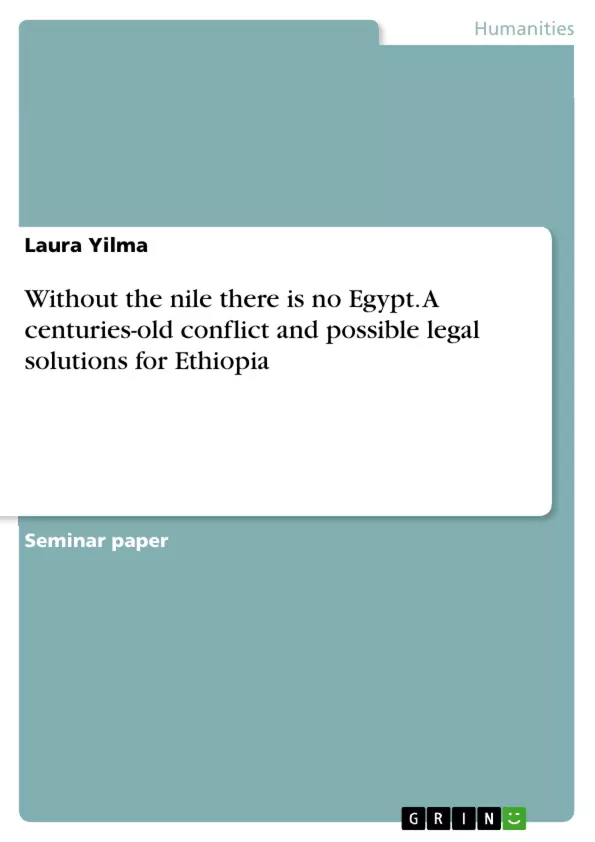This term paper aims at what legal tools Ethiopia can consider fighting Egypt's hegemony and revoke the Nile treaties to avoid future conflicts in the Horn of Africa over the use of the Nile waters and to improve the livelihood in region. My Thesis is that the construction of the Grand Ethiopian Renaissance Dam poses no threat to Egypt and in this paper, I will provide a historical and geographical overview of the geopolitical conflict, followed by an explanation of the treaties that Egypt has invoked to date. I will then provide an overview of Ethiopia's legal development since 1959. At the end, I will then draw an appropriate conclusion. The following provides a geographical overview of the Nile River basin.
According to an article in the New York Times "Without the Nile, there is no Egypt." (Walsh & Sengupta, 2020). The construction in 2011 of the largest dam "Grand Ethiopian Renaissance Dam" also known as GERD has caused dispute for centuries between Egypt and Ethiopia, which despite several negotiations, also with the African Union as a mediator, cannot agree on the utilization of the dam. Egypt obtains most of the water it needs from the Nile which flows from Lake Tana in Ethiopia into the Blue Nile and from Lake Victoria originating in the White Nile, which crosses the borders of Kenya, Uganda and Tanzania. Ethiopia on the other side is one of the countries with one of the fastest growing economies in Africa, at the same time over half of the population in the country live without electricity, which could be remedied by the construction and use of the dam. However, Egypt fears that Ethiopia could now gain control over the flow of the river, citing an old Anglo-Egyptian colonial treaty signed between the United Kingdom and Egypt on behalf of Ethiopia in 1929 that promises Egypt veto power and rights over the distribution and use of the Nile waters to this day.
Table of Contents
- Introduction
- Geographical Overview
- Share of Water volume
- Geopolitical context
- Grand Ethiopian Renaissance Dam
- Legal Framework
- Treaties
- Treaty from 1891
- Treaty from 1902
- Nile Water Agreement from 1929
- Treaty from 1959
- Legal developments since 1959
- Treaties
- Conclusion
Objectives and Key Themes
This term paper aims to explore the legal tools Ethiopia can consider to challenge Egypt's dominance over the Nile and potentially revoke the Nile treaties. This is to prevent future conflicts in the Horn of Africa over the use of Nile waters and improve the livelihood of the region. The paper argues that the construction of the Grand Ethiopian Renaissance Dam does not pose a threat to Egypt.
- Historical and geographical overview of the geopolitical conflict surrounding the Nile
- Analysis of treaties invoked by Egypt to assert its claim over Nile waters
- Examination of Ethiopia's legal developments since 1959
- Exploration of legal strategies for Ethiopia to assert its water rights
- Assessment of the impact of the Grand Ethiopian Renaissance Dam on regional stability and livelihoods
Chapter Summaries
The introduction highlights the historical conflict between Egypt and Ethiopia over the Nile River and the construction of the Grand Ethiopian Renaissance Dam. It introduces the paper's thesis, which posits that the dam does not threaten Egypt and explores the legal strategies available to Ethiopia to challenge Egypt's dominance over the Nile.
The geographical overview provides a detailed explanation of the Nile River basin, its flow through various countries, and the contributions of different countries to the Nile's water volume. It emphasizes the importance of Lake Tana in Ethiopia and Lake Victoria as key sources of water for the Nile.
The geopolitical context section focuses on the Grand Ethiopian Renaissance Dam, its construction, and its implications for the relationship between Egypt and Ethiopia. It delves into the history of the dispute, the role of the African Union as a mediator, and the concerns of Egypt regarding Ethiopia's potential control over the Nile's flow.
The legal framework chapter delves into the various treaties that have historically governed the use of the Nile River. It examines the Nile Water Agreement of 1929, which grants Egypt veto power over the distribution of Nile waters, and analyzes other relevant treaties from 1891, 1902, and 1959. This section also discusses the legal developments since 1959 in the context of Ethiopia's evolving position on the Nile.
Keywords
The paper focuses on key concepts such as the Nile River, the Grand Ethiopian Renaissance Dam, the geopolitical conflict between Egypt and Ethiopia, Nile treaties, legal frameworks, water rights, and regional stability. It examines the historical context, current developments, and potential legal strategies for resolving the ongoing dispute over the Nile's water resources.
- Arbeit zitieren
- Laura Yilma (Autor:in), 2021, Without the nile there is no Egypt. A centuries-old conflict and possible legal solutions for Ethiopia, München, GRIN Verlag, https://www.grin.com/document/1030900



